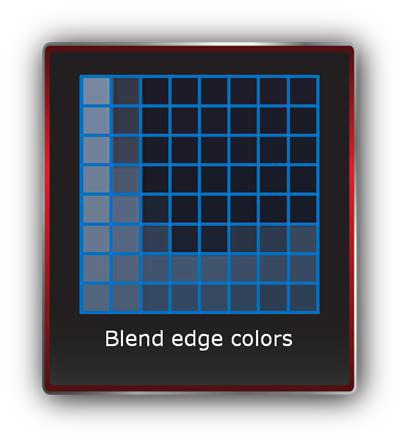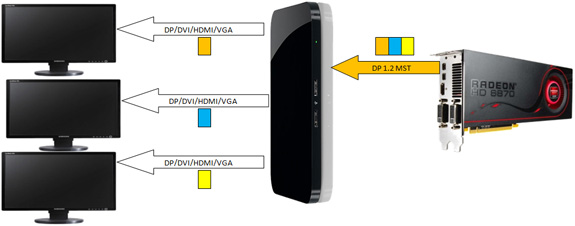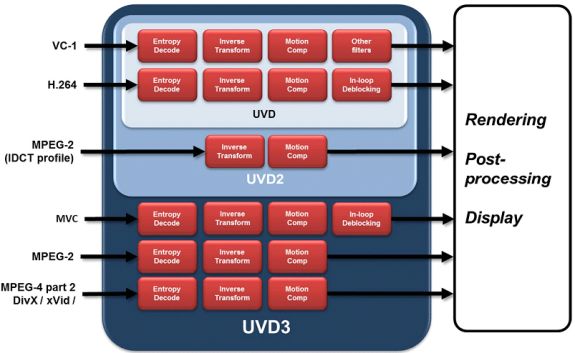AMD's Radeon HD 6970 & Radeon HD 6950: Paving The Future For AMD
by Ryan Smith on December 15, 2010 12:01 AM ESTRefresher: The 6800 Series’ New Features
Back in October AMD launched the first 6000 series cards, the Barts-based Radeon HD 6800 series. At their core they are a refreshed version of the Cypress GPU that we saw on the 5800 series, but AMD used the opportunity to make some enhancements over the standard Cypress. All of these enhancements apply throughout the 6000 series, so this includes the 6900 series. As such for those of you who didn’t pay much attention to the 6800 series, we’re going to quickly recap what’s new in order to lay the groundwork for further comparisons of the 6900 series to the 5800 series.
We’ll start with the core architecture. Compared to Cypress, Barts is nearly identical save 1 difference: the tessellator. For Barts AMD implemented what they call their 7th generation tessellator, which focused on delivering improved tessellation performance at lower tessellation factors that AMD felt were more important. Cayman takes this one step further and implements AMD’s 8th generation tessellator, which as the naming conventions implies is the 7th generation tessellator with even further enhancements (particularly those necessary for load balancing).
The second change we saw with Barts and the 6800 series was AMD’s refined texture filtering engine. AMD’s texture filtering engine from the 5800 set new standards by offering angle independent filtering, but it had an annoying quirk with highly regular/noisy textures where it didn’t do a good enough job blending together various mipmaps, resulting in visible transitions between them. For the 6800 series AMD fixed this, and it can now properly blend together noisy textures. At the same time in a controversial move AMD tweaked its default filtering optimizations for the 5800 series and entire 6000 series, leading to these cards producing imagines subtly different (and depending on who you ask, subtly worse) than they were on the 5800 series prior to the Catalyst 10.10 drivers.

| Radeon HD 5870 | Radeon HD 6870 | GeForce GTX 480 |
The third change we saw was the introduction of a new anti-aliasing mode, initially launched on the 6800 series and backported to the 5800 series shortly thereafter. Morphological Anti-Aliasing (MLAA) is a post-processing filter that works on any (and all) images, looking for high contrast edges (jaggies) and blending them to reduce the contrast. Implemented as a compute shader, it works with all games. As it’s a post-processing filter the results can vary – the filter has no knowledge of depth, polygons, or other attributes of the rendered world beyond the final image – so it’s prone to blending everything that looks like aliasing. On the plus side it’s cheap to use as it was originally designed for consoles with their limited resources, so by not consuming large amounts of memory & memory bandwidth like SSAA/MSAA it usually has a low performance hit.


Last but not least, AMD made a number of changes to their display hardware. The Universal Video Decoder (UVD) was upgraded to version 3, bringing full decode support for MPEG-2, MPEG-4 ASP, and H.264 MVC (packed frame video for 3D movies). For the 6900 series this is not of great importance as MPEG-2 and MPEG-4 ASP are low complexity codecs, but it does play an important role for AMD’s future APU products and low-end GPUs, where offloading these low complexity codecs is still going to be a big relief for the slower CPUs they’re paired with. And on that note the first public version of the DivX codec with support for UVD3 will be shipping today, letting 6800/6900 series owners finally take advantage of this functionality.
The second of the major display changes was the addition of support for the DisplayPort 1.2 standard. DP1.2 doubles DisplayPort’s bandwidth to 21.6Gbps, finally giving DisplayPort a significant bandwidth lead over dual-link DVI. With double the bandwidth it’s now possible to drive multiple monitors off of a single root DisplayPort, a technology called Multi Stream Transport (MST). AMD is heavily banking on this technology, as the additional bandwidth coupled with the fact that DisplayPort doesn’t require a clock source for each monitor/stream means AMD can drive up to 6 monitors off of a single card using only a pair of mini-DP ports. AMD is so cutting edge here that like the 6800 series the 6900 series is technically only DP1.2 ready – there won’t be any other devices available for compliance testing until 2011.

Finally, the 6800 series also introduced support for HDMI 1.4a and support for color correction in linear space. HDMI 1.4a support is fairly straightforward: the 6000 series can drive 3D televisions in either the 1080p24 or 720p60 3D modes. Meanwhile support for color correction in linear space allows AMD to offer accurate color correction for wide gamut monitors; previously there was a loss of accuracy as color correction had to be applied in the gamma color space, which is only meant for use for display purposes. This is particularly important for integrating wide gamut monitors in to traditional gamut workflows, as sRGB is misinterpreted on a wide gamut monitor without color correction.
While all of these features were introduced on the 6800 series, they’re fundamental parts of the entire 6000 series, meaning they’re part of the 6900 series too. This provides us with a baseline set of improvements over AMD’s 5800 series, on top of the additional improvements Cayman and AMD’s VLIW4 architecture brings.











168 Comments
View All Comments
Ryan Smith - Wednesday, December 15, 2010 - link
AMD rarely has Linux drivers ready for the press ahead of a launch. This is one such occasion.MeanBruce - Wednesday, December 15, 2010 - link
Great job on the review Ryan, hope you will cover the upcoming Nvidia 560 and 550 when they arrive. Peace Brother!gescom - Wednesday, December 15, 2010 - link
Please Anand make an update with a new 10.12 driver. Great review btw.knowom - Wednesday, December 15, 2010 - link
Until you keep into consideration1) Driver support
2) Cuda
3) PhysX
I also prefer the lower idle noise, but higher load noise than the reverse for Ati because when your gaming usually you have your sound turned up a lot it's when you aren't gaming is when noise is more of the issue for seeking a quieter system.
It's a better trade off in my view, but they are both pretty even in terms of noise for idle and load regardless and a far cry from quite compared to other solutions from both vendors if that's what your worried about not to mention non reference cooler designs effect that situation by leaps and bounds..
Acanthus - Wednesday, December 15, 2010 - link
AMD has been updating drivers more aggressively than Nvidia lately. (the last year)Anecdotally, my GTX285 has had a lot more game issues than my 4890. Specifically in NWN2 and Civ5.
Cuda is irrelevant unless you are doing heavy 1. photoshop, 2. video encoding.
PhysX is still a crappy gimmick at this point and needs to offer real visual improvements without a 40%+ performance hit.
smookyolo - Wednesday, December 15, 2010 - link
PhysX may be a gimmick in games, but it's one of the better ones.Also, guess what... it's being used all over the 3D animation industry.
And guess where the real money comes from? The industry.
fausto412 - Wednesday, December 15, 2010 - link
physx is a gimmick that has been around for some time and will never take hold. when physx came around it set a new standard but since then developers have adopted havok more commonly since it doesn't require extra hardware.it's all marketing and not a worthy decision point when buying a new card
jackstar7 - Wednesday, December 15, 2010 - link
Alternately, my triple-monitor setup makes AMD the obvious choice.beepboy - Wednesday, December 15, 2010 - link
Agreed on triple-monitor setup. You can make the argument that 2x 460s are cheaper and nets better performance but at the end of the day 2x 460s will be louder, use more power, more heat, etc over a single 69xx. I just want my triple monitor setup, damn it.codedivine - Wednesday, December 15, 2010 - link
Any info on cache sizes and register files?